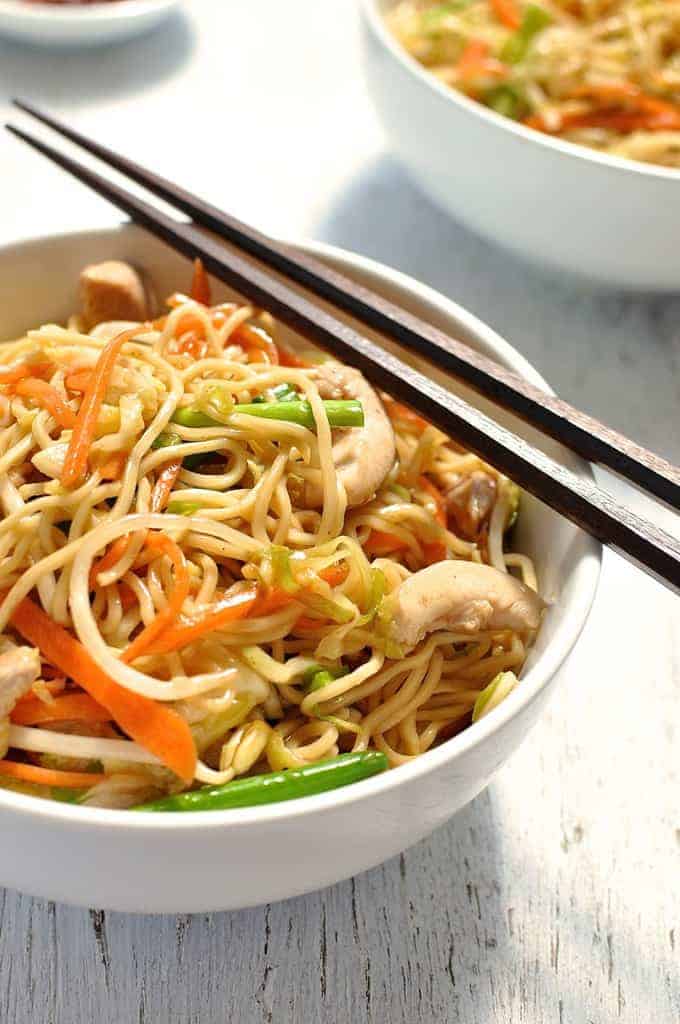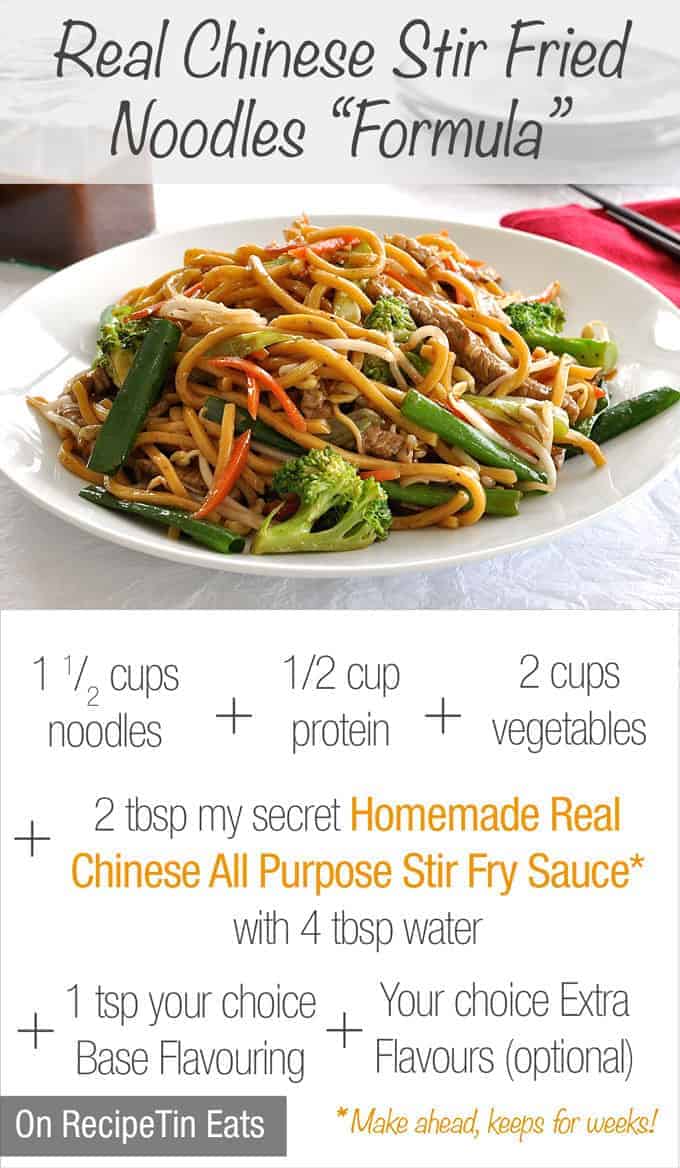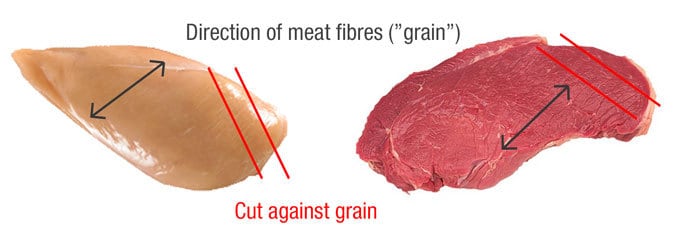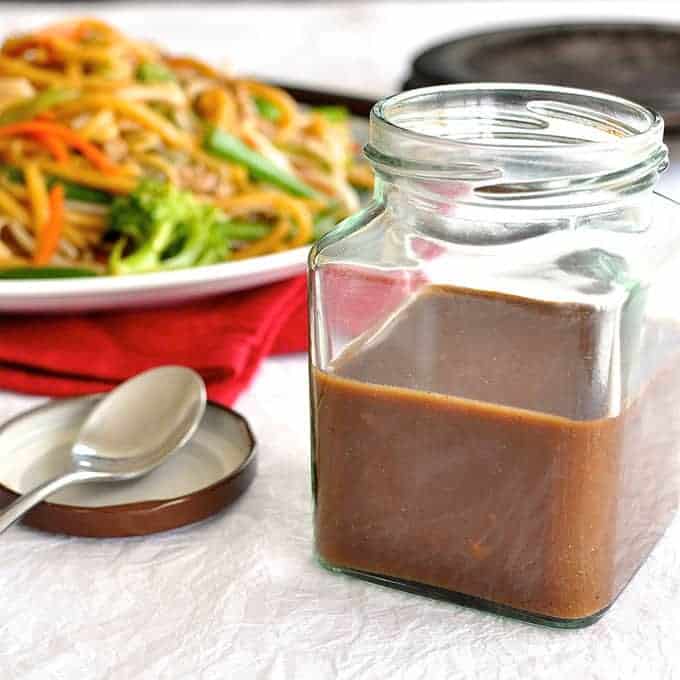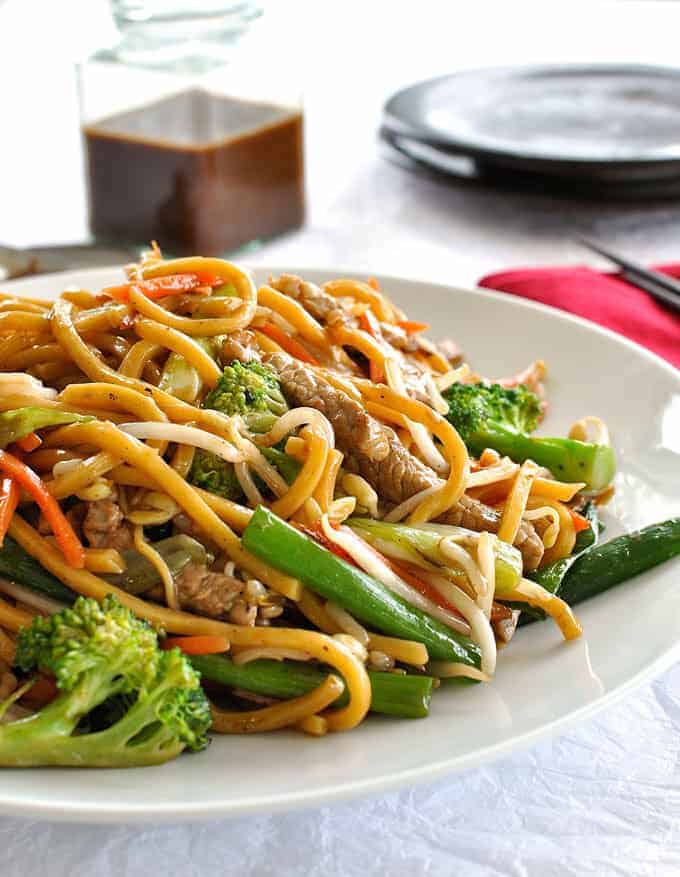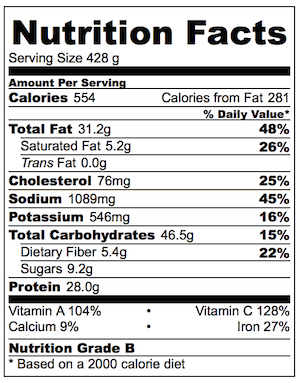A blank canvas for Chinese Stir Fry Noodles
I rarely use a recipe for stir fry noodles I make on a day to day basis, because after making it hundreds (and hundreds!) of times, the “formula” is embedded deep in me which means I can throw one together using virtually any ingredients. And I swear, I’ve never had a disaster failure. Some are better than others, and I’ve experimented with stir frying some strange ingredients (umm…parsnip in stir fries is weird), but overall it’s always tasty and I happily scoff down a large bowl and go back for seconds. So in this post I’m sharing a guide for how to “build your own” Chinese stir fry noodles using my Real Chinese All Purpose Stir Fry Sauce. The “formula” is really simple – this is for 1 serving: 1 1/2 cups noodles + 1/2 cup protein + 2 to 3 cups (packed) vegetables* + 2 tbsp Real Chinese All Purpose Stir Fry Sauce + 1/4 cup water + Optional Add Ons (Base Flavour and Additional Flavourings)
- I love having loads of vegetables. But really it depends on your personal taste, and the “normal” amount tends to be 2 cups per serving (but pack the cup. Pack it good! Veggies are good for you!) Read on below for guidance on each of these components, plus I’ve included a printable recipe at the bottom summarising this post.
Noodles – you can use any noodles you want, dried or fresh, except vermicelli (too thin for this sauce) and the egg noodles for soups (the ones that come in the packet coated with cornflour/cornstarch – it makes the stir fry too thick and gluggy). Cook the dried noodles according to the packet instructions. If using dried rice noodles, I like to “cook” them simply by pouring over plenty of boiling water and leaving them in a bowl for 5 minutes or so. As with most recipes, it’s better to use fresh rather than dried noodles. My favourite fresh noodles to stir fry is hokkien noodles – I can find them fresh in pretty much any supermarket, and it’s a really versatile noodle – I use it in soups, and you can make stir fries for pretty much any Asian cuisine (Thai, Japanese, Malaysian, Singaporean). However, fresh rice noodles are not readily available in supermarkets here in Sydney, you have to get them from Asian stores, so I usually make this with dried rice noodles (which are readily available – plus they are way cheaper than fresh noodles!). Protein – use whatever proteins you want, meat, shrimp or tofu. For meat, slice it against the grain. Slice the meat thinly so it cooks quickly – 1/4″ / 0.5cm slices.
Vegetables – you can use pretty much any vegetables you want for stir fry noodles, though some vegetables I haven’t seen in stir fries like tomatoes and beetroot. But hey, if that works for you, then go for it! Here is a guide for how to cut the vegetables so they cook in roughly the same time: That’s right. Your cheerful local Chinese restaurant is using economical stewing beef to make stir fries with ultra tender strips of beef by tenderising it! Find out how to use this simple, highly effective method: How to Tenderise Beef (the Chinese way). This is optional only, when wanting to make stir fries with economical beef or you simply want extra tender beef, Chinese restaurant style!
Onions – 1/4″/0.5cm slices. Firm vegetables (eg.carrots, zucchini) – slice into 1/5″ / 3mm slices. I like to cut carrots on the diagonal, then either vertically in half or sometimes I julienne it. Leafy chinese greens (eg. bok choy/pak choy/Chinese broccoli) – separate leaves from stems, cut stems vertically into roughly 1/2″/1cm sticks. Cabbage – shred. As chinese cabbage is softer, you can also cut it into larger pieces of 1.5″/4cm x 1″ / 2 cm. Broccoli and cauliflower – cut/break into florets no larger than half the size of a golf ball (including the stem). Green beans, snap peas, baby corn – whole (trimmed). Eggplant – sliced into 1/3″/1cm thick bite size slices. Scallions / shallots – either sliced thinly or into 2″/4cm pieces. Beansprouts – use as is.
Real Chinese All Purpose Stir Fry Sauce – this is my personal secret recipe which I shared earlier this week. It’s a versatile base for Chinese stir fries that you can store in the fridge for weeks – months even. It makes a great glossy sauce that coats your stir fries, and you can tailor it to your taste by adding spice, some tang, fresh herbs, and even a fruity sweetness by adding juice. Having it on hand makes mid week meals a breeze because all you do is give it a shake, then add it to any stir fry – rather than scrambling around gathering 10 ingredients for your stir fry sauce.
Base Flavours – these are the flavours that infuse into the oil before you add the other ingredients. You can use garlic, ginger or chilli (fresh – if using a paste, add it as an Extra Flavouring).
Extra Flavourings – these are the extra flavours you add when you add the sauce into the wok. You can sweeten it with sugar, add some tang with vinegar, add some heat with chilli paste or sriracha, add herbs like coriander or Thai Basil leaves, sweet chilli sauce, or even add a touch of sweet and fruit with fruit juice. I’ve provided my favourite variations in the recipe below. Cooking the Stir Fry – the golden rule for a successful stir fry noodles is to add the ingredients into the wok in order of length of time to cook. You need to take into account the ingredient itself (proteins and hard vegetables take longer than soft vegetables) and the size that you have cut them. As a guide, start with onion and proteins, stir fry for 1 minute, then add florets (broccoli, cauliflower), then 1 minute later add firm vegetables like carrots, and finish with delicate vegetables like snow peas. I always leave leafy greens (like spinach and the leaves of Chinese greens like bok choy) and bean sprouts until when I add the noodles otherwise I find they overcook and look limp and miserable. Lastly, add the noodles, sauce and other Extra Flavourings of your choice, as well as leafy greens, stir fry for another minute, and you’re done. Key Tip: Get all your ingredients / sauce prepared and ready next to the wok. Once you start cooking, it comes together quickly and you don’t want to be scrambling around the kitchen!! I hope you find this guide useful! A printable recipe with a condensed version of this guide is below.
Save this Stir Fry Noodles “formula” to your Asian Meals Pinterest Board!
SaveSave
